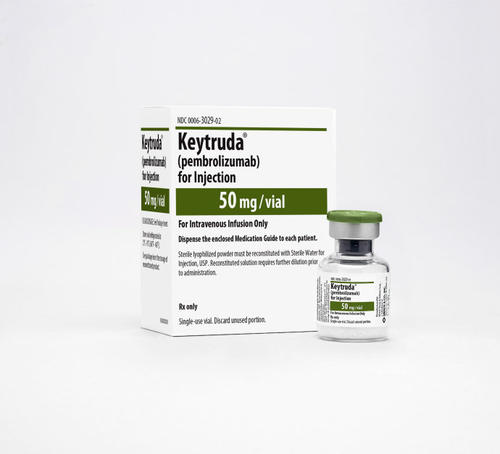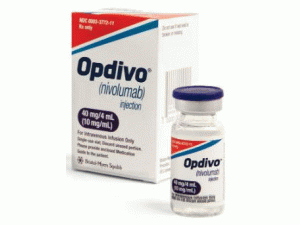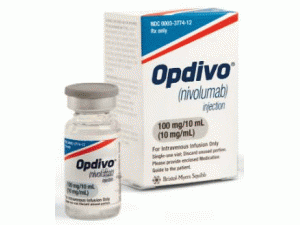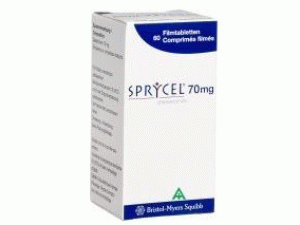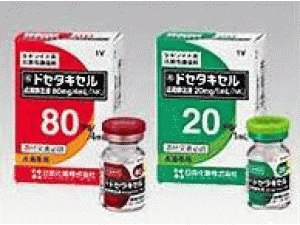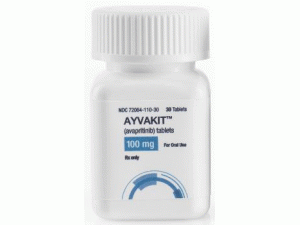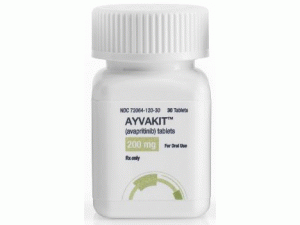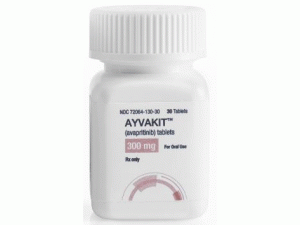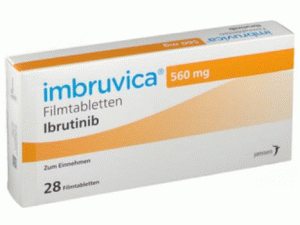曲贝替定冻干粉注射剂trabectedin(Yondelis powder injection 1mg)
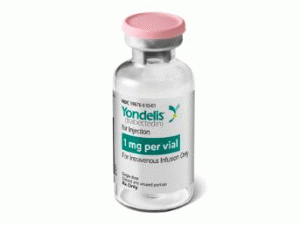 产地国家:美国
处方药:是
所属类别: 1毫克/瓶
包装规格: 1毫克/瓶
计价单位:瓶
生产厂家英文名:ortho biotech
原产地英文商品名:Yondelis powder injection 1mg/vial
原产地英文药品名:Trabectedin
中文参考商品译名:Yondelis冻干粉注射剂 1毫克/瓶
中文参考药品译名:曲贝替定
产地国家:美国
处方药:是
所属类别: 1毫克/瓶
包装规格: 1毫克/瓶
计价单位:瓶
生产厂家英文名:ortho biotech
原产地英文商品名:Yondelis powder injection 1mg/vial
原产地英文药品名:Trabectedin
中文参考商品译名:Yondelis冻干粉注射剂 1毫克/瓶
中文参考药品译名:曲贝替定
简介:
近日,美国FDA批准化疗药物Yondelis(Trabectedin;中文名:曲贝替定)用于不能手术切除或晚期(转移性的)特定软组织肉瘤(STS)- 脂肪肉瘤与平滑肌肉瘤治疗。这款药物获批用于既往接受过蒽环霉素化疗的患者。FDA的药品评价和研究中心中血液学和肿瘤产品室主任说:“晚期或转移软组织肉瘤的治疗代表一个对患者有很少有效治疗选择可得到的困难挑战,”“今天 Yondelis的批准对晚期或转移脂肪肉瘤和平滑肌肉瘤提供一个治疗选择。”优先审评批准日期:2015年10月23日;公司:Janssen Biotech,Inc.YONDELIS(曲贝替定[trabectedin])用于注射,用于静脉注射。 作用机制:Trabectedin是一种烷化药物,可以结合DNA小沟中的鸟嘌呤残基,形成加合物,导致DNA螺旋向大沟弯曲。 加合物形成触发一系列事件,这些事件可影响DNA结合蛋白的后续活性,包括一些转录因子和DNA修复途径,导致细胞周期的扰动和最终的细胞死亡。 适应症:YONDELIS是一种烷化药物,用于治疗无法切除或转移性脂肪肉瘤或平滑肌肉瘤的患者,这些患者接受过含蒽环类药物治疗方案。 用法用量:通过中心静脉线每3周施用1.5mg/m2体表面积作为24小时静脉输注。 术前用药:静脉注射地塞米松20mg,每次输注前30分钟。 肝功能损害:在中度肝功能损害患者中,每3周通过中心静脉输注0.9mg/m2体表面积作为24小时静脉输注。 剂量形式:用于注射,在单剂量小瓶中的1mg无菌冻干粉末。 禁忌症:已知对trabectedin的超敏反应。 警告和注意事项: 中性粒细胞减少性败血症:可能发生严重和致命的中性粒细胞减少性败血症。在治疗期间监测中性粒细胞计数。扣留YONDELIS的中性粒细胞计数<1,500/mcL。 横纹肌溶解症:可能发生横纹肌溶解症。每次给药前监测肌酸磷酸激酶(CPK)水平。扣留YONDELIS的CPK超过正常上限的2.5倍。 肝毒性:可能发生肝毒性。如果需要,监测并延迟和/或减少剂量。 心肌病:可发生严重和致命的心肌病。左心室射血分数(LVEF)<正常下限,先前累积蒽环类药物剂量≥300mg/m2,年龄≥65岁或心血管疾病史的患者可能发生新的或恶化的心脏功能障碍的风险增加。停止出现LVEF或心肌病减少的患者的YONDELIS。 毛细血管渗漏综合征:监测和停止YONDELIS毛细血管渗漏综合症。 胚胎 - 胎儿毒性:可导致胎儿伤害。建议对胎儿的潜在风险并使用有效的避孕措施。 不良反应: 最常见(≥20%)的不良反应是恶心,疲劳,呕吐,便秘,食欲减退,腹泻,外周性水肿,呼吸困难和头痛。 最常见(≥5%)3-4级实验室异常包括中性粒细胞减少,ALT升高,血小板减少,贫血,AST升高和肌酸磷酸激酶增加。 药物相互作用: CYP3A抑制剂:避免伴随强效CYP3A抑制剂。 CYP3A诱导剂:避免伴随的强CYP3A诱导剂。 用于特定人群哺乳期:建议不要母乳喂养。不要对患有严重肝功能损害的患者进行YONDELIS治疗。 存储:将YONDELIS样品瓶存放在2°C至8°C(36°F至46°F)的冰箱中。 完整说明书附件:https://dailymed.nlm.nih.gov/dailymed/drugInfo.cfm?setid=472bd78e-be17-4b9d-90f4-9482c3aec9ff英文版说明书:
YONDELIS(trabectedin)INDICATIONYONDELIS®(trabectedin)is indicated for the treatment of patients with unresectable or metastatic liposarcoma or leiomyosarcoma who received a prior anthracycline-containing regimen.IMPORTANT SAFETY INFORMATIONCONTRAINDICATIONS—YONDELIS® (trabectedin) is contraindicated in patients with known severe hypersensitivity, including anaphylaxis, to trabectedin.WARNINGS AND PRECAUTIONSNeutropenic sepsis, including fatal cases, can occur. In Trial ET743-SAR-3007, the incidence of Grade 3 or 4 neutropenia, based on laboratory values, was 43% (161/378). Median time to the first occurrence of Grade 3 or 4 neutropenia was 16 days (range: 8 days to 9.7 months). Median time to complete resolution of neutropenia was 13 days (range: 3 days to 2.3 months). Febrile neutropenia (fever ≥38.5°C with Grade 3 or 4 neutropenia) occurred in 18 patients (5%). Ten patients (2.6%) experienced neutropenic sepsis, 5 of whom had febrile neutropenia, which was fatal in 4 patients (1.1%). Assess neutrophil count prior to administration of each dose of YONDELIS® and periodically throughout the treatment cycle. Withhold YONDELIS® for neutrophil counts of less than 1500 cells/microliter on the day of dosing. Permanently reduce the dose of YONDELIS® for life-threatening or prolonged, severe neutropenia in the preceding cycle.Rhabdomyolysis—YONDELIS® can cause rhabdomyolysis and musculoskeletal toxicity. In Trial ET743-SAR-3007, rhabdomyolysis leading to death occurred in 3 (0.8%) of the 378 patients. Elevations in creatine phosphokinase (CPK) occurred in 122 (32%) of the 378 patients receiving YONDELIS®, including Grade 3 or 4 CPK elevation in 24 patients (6%), compared to 15 (9%) of the 172 patients receiving dacarbazine with any CPK elevation, including 1 patient (0.6%) with Grade 3 CPK elevation. Among the 24 patients receiving YONDELIS® with Grade 3 or 4 CPK elevation, renal failure occurred in 11 patients (2.9%); rhabdomyolysis with the complication of renal failure occurred in 4 of these 11 patients (1.1%). Median time to first occurrence of Grade 3 or 4 CPK elevations was 2 months (range: 1 to 11.5 months). Median time to complete resolution was 14 days (range: 5 days to 1 month). Assess CPK levels prior to each administration of YONDELIS®. Withhold YONDELIS® for serum CPK levels more than 2.5 times the upper limit of normal. Permanently discontinue YONDELIS® for rhabdomyolysis.Hepatotoxicity, including hepatic failure, can occur. Patients with serum bilirubin levels above the upper limit of normal or AST or ALT levels >2.5 x ULN were not enrolled in Trial ET743-SAR-3007. In Trial ET743-SAR-3007, the incidence of Grade 3-4 elevated liver function tests (defined as elevations in ALT, AST, total bilirubin, or alkaline phosphatase) was 35% (134/378). Median time to development of Grade 3-4 elevation in ALT or AST was 29 days (range: 3 days to 11.5 months). Of the 134 patients with Grade 3 to 4 elevations in LFTs, 114 (85%) experienced complete resolution with the median time to complete resolution of 13 days (range: 4 days to 4.4 months). In Trial ET743-SAR-3007, the incidence of drug-induced liver injury (defined as concurrent elevation in ALT or AST of more than three times the upper limit of normal, alkaline phosphatase less than two times the upper limit of normal, and total bilirubin at least two times the upper limit of normal) was 1.3% (5/378). ALT or AST elevation greater than eight times the ULN occurred in 18% (67/378) of patients. Assess LFTs prior to each administration of YONDELIS® and as clinically indicated based on underlying severity of pre-existing hepatic impairment. Manage elevated LFTs with treatment interruption, dose reduction, or permanent discontinuation based on severity and duration of LFT abnormality.Cardiomyopathy, including cardiac failure, congestive heart failure, ejection fraction decreased, diastolic dysfunction, or right ventricular dysfunction can occur. In Trial ET743-SAR-3007, patients with a history of New York Heart Association Class II to IV heart failure or abnormal left ventricular ejection fraction (LVEF) at baseline were ineligible. In Trial ET743-SAR-3007, cardiomyopathy occurred in 23 patients (6%) receiving YONDELIS® and in four patients (2.3%) receiving dacarbazine. Grade 3 or 4 cardiomyopathy occurred in 15 patients (4%) receiving YONDELIS® and 2 patients (1.2%) receiving dacarbazine; cardiomyopathy leading to death occurred in 1 patient (0.3%) receiving YONDELIS® and in none of the patients receiving dacarbazine. The median time to development of Grade 3 or 4 cardiomyopathy in patients receiving YONDELIS® was 5.3 months (range: 26 days to 15.3 months). Assess left ventricular ejection fraction (LVEF) by echocardiogram or multigated acquisition (MUGA) scan before initiation of YONDELIS® and at 2- to 3-month intervals thereafter until YONDELIS® is discontinued. Withhold YONDELIS® for LVEF below lower limit of normal. Permanently discontinue YONDELIS® for symptomatic cardiomyopathy or persistent left ventricular dysfunction that does not recover to lower limit of normal within 3 weeks.Capillary Leak Syndrome (CLS) characterized by hypotension, edema, and hypoalbuminemia has been reported with YONDELIS®, including serious CLS resulting in death. Monitor for signs and symptoms of CLS. Discontinue YONDELIS® and promptly initiate standard management for patients with CLS, which may include a need for intensive care.Extravasation Resulting in Tissue Necrosis — Extravasation of YONDELIS®, resulting in tissue necrosis requiring debridement, can occur. Evidence of tissue necrosis can occur more than 1 week after the extravasation. There is no specific antidote for extravasation of YONDELIS®. Administer YONDELIS® through a central venous line.Embryofetal Toxicity—Based on its mechanism of action, YONDELIS® can cause fetal harm when administered to a pregnant woman. Advise females of reproductive potential to use effective contraception during therapy and for at least 2 months after the last dose of YONDELIS®. Advise males with female partners of reproductive potential to use effective contraception during therapy and for at least 5 months after the last dose of YONDELIS®.Adverse Reactions—The most common (≥20%) adverse reactions are nausea (75%), fatigue (69%), vomiting (46%), constipation (37%), decreased appetite (37%), diarrhea (35%), peripheral edema (28%), dyspnea (25%), and headache (25%).The most common (≥5%) grades 3-4 laboratory abnormalities are: neutropenia (43%), increased ALT (31%), thrombocytopenia (21%), anemia (19%), increased AST (17%), and increased creatine phosphokinase (6.4%).DRUG INTERACTIONSEffect of Cytochrome CYP3A Inhibitors — Avoid using strong CYP3A inhibitors (e.g., oral ketoconazole, itraconazole, posaconazole, voriconazole, clarithromycin, telithromycin, indinavir, lopinavir, ritonavir, boceprevir, nelfinavir, saquinavir, telaprevir, nefazodone, conivaptan) in patients taking YONDELIS®. If a strong CYP3A inhibitor for short-term use (i.e., less than 14 days) must be used, administer the strong CYP3A inhibitor 1 week after the YONDELIS® infusion, and discontinue it the day prior to the next YONDELIS® infusion.Effect of Cytochrome CYP3A Inducers — Avoid using strong CYP3A inducers (e.g., rifampin, phenobarbital, St. John's wort) in patients taking YONDELIS®.用药温馨提示:当您服用此药物时,需定期接受医疗专业人士的检查,以便随时针对其药效、副作用等情况进行监测。本网站所包含的信息旨在为患者提供帮助,不能代替医学建议和治疗。
药品价格查询,专业药品查询网站,药品说明书查询,药品比价 » 曲贝替定冻干粉注射剂trabectedin(Yondelis powder injection 1mg)
药品价格查询,专业药品查询网站,药品说明书查询,药品比价 » 曲贝替定冻干粉注射剂trabectedin(Yondelis powder injection 1mg)

